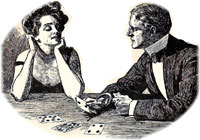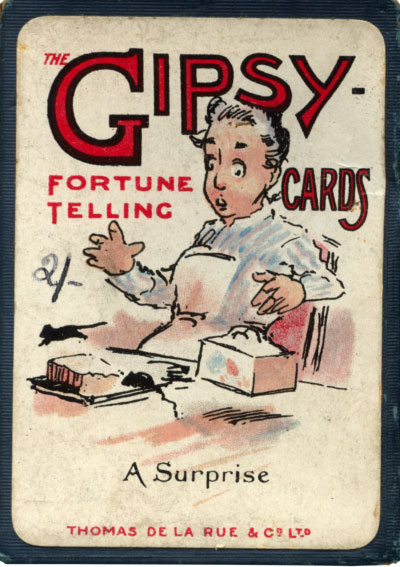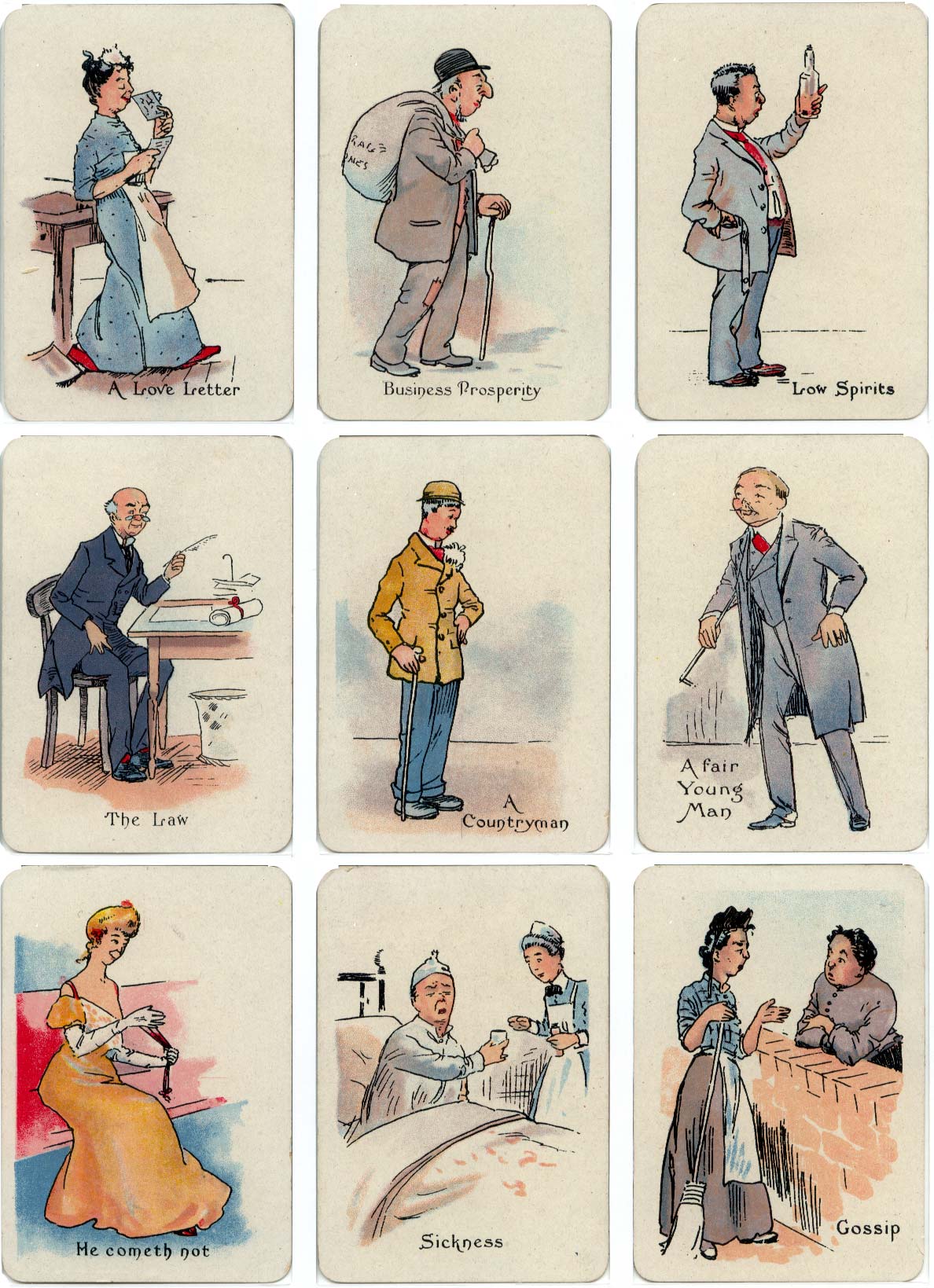Gipsy Fortune Telling Cards
“Gipsy” fortune-telling cards with original artwork by Hylton Cock, published by Thomas de la Rue & Co Ltd., c.1910.
The “Gipsy” fortune-telling cards with original artwork by Hylton Cock were published by Thomas de la Rue & Co Ltd in c.1910. The pack comes in a stiff slide-box embellished with gold on dark green, and contains thirty-three cards, thirty-two of which are illustrated in colour with designs of various meanings. The thirty-third card is left blank and represents the person whose fortune is being told.
The cards have no suit symbols or numbers, just a title. At least two different back designs are known. The same images were also published as “The Wizard Fortune Telling Cards” by Milton Bradley Co (Springfield, USA) in 1908 with plain cream backs.


The Edwardian artwork, from just after the Victorian era, reflects the historical character and visual culture of the beginning of the 20th century when traditional values were still in place but modernity was about to emerge. The instructions included with the cards state that “it must be remembered that fortune tellers do not pretend that a pack of cards can of itself tell a person’s fortune, the claim invariably being that the medium tells the fortune and uses the cards as his instruments.”


Above: “Gipsy” fortune-telling cards with original artwork by Hylton Cock published by Thomas de la Rue & Co Ltd., c.1910. Images courtesy Rex Pitts.

By Rex Pitts (1940-2021)
Member since January 30, 2009
Rex's main interest was in card games, because, he said, they were cheap and easy to get hold of in his early days of collecting. He is well known for his extensive knowledge of Pepys games and his book is on the bookshelves of many.
His other interest was non-standard playing cards. He also had collections of sheet music, music CDs, models of London buses, London Transport timetables and maps and other objects that intrigued him.
Rex had a chequered career at school. He was expelled twice, on one occasion for smoking! Despite this he trained as a radio engineer and worked for the BBC in the World Service.
Later he moved into sales and worked for a firm that made all kinds of packaging, a job he enjoyed until his retirement. He became an expert on boxes and would always investigate those that held his cards. He could always recognize a box made for Pepys, which were the same as those of Alf Cooke’s Universal Playing Card Company, who printed the card games. This interest changed into an ability to make and mend boxes, which he did with great dexterity. He loved this kind of handicraft work.
His dexterity of hand and eye soon led to his making card games of his own design. He spent hours and hours carefully cutting them out and colouring them by hand.
Related Articles

Scientific Whist
“Scientific Whist” : standard cards with instructions for play on the faces by Chas Goodall & Son, 1...

Agent Provocateur
Branded lingerie collection in a pack of pin-up playing cards.

Nimbus playing cards
Mike Steer’s weather-themed pack with suits in four colours and backs for cardistry.

Agatha Christie and Playing Cards revisited
Agatha Christie uses card-play as a primary focus of a story, and as a way of creating plots and mot...

The Decadent Deck
Studies in the eroticism of the female body by Inge Clayton.

Historic Shakespeare
“Historic Shakespeare” playing cards featuring Shakespearean characters by Chas Goodall & Son.

Copechat Paramount Sorting System
Preserving the past: a specimen deck showcasing edge-notched cards and their ingenious sorting syste...

Heartsette by Herbert Fitch & Co, 1893
A glimpse into a busy print and design office in late Victorian London.

Batman® playing cards
Batman playing cards published by InterCol of London 1989.

Can You Believe Your Eyes?
“Can You Believe Your Eyes?” playing cards featuring visual illusions & other oddities.

Pastime Playing Cards for the Blind
The “Pastime” Playing Cards for the Blind manufactured by Goodall & Son Limd., c.1910.

Songs with Flute accompaniment
Eighteenth century English engraved cards with music for voice and flute.

Love Tests
Vintage novelty “Love Test” cards of a slightly saucy nature but all in good fun!

Ben 10 playing cards
Characters from the American animated television science fantasy series Ben 10.

Doctor Who Trump Card Game
Game for two players in which Doctor Who and the Legendary Legion join battle with the Alien Hordes....

Tarot hiéroglyphique égyptien
The design of the cards draws inspiration from various religious and philosophical traditions merged...
Most Popular
Our top articles from the past 28 days



